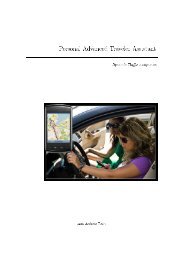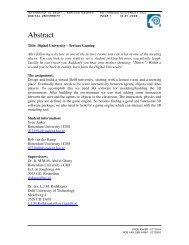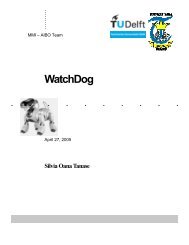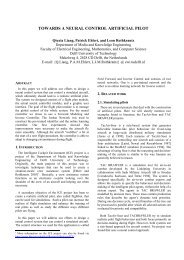Recognition of facial expressions - Knowledge Based Systems ...
Recognition of facial expressions - Knowledge Based Systems ...
Recognition of facial expressions - Knowledge Based Systems ...
You also want an ePaper? Increase the reach of your titles
YUMPU automatically turns print PDFs into web optimized ePapers that Google loves.
A small part <strong>of</strong> the output text file is as it is presented in<br />
Listing 6. The first item on each row stands for the identification number <strong>of</strong> the subject.<br />
The second item identifies the number <strong>of</strong> the recording sequence. The third item <strong>of</strong> every<br />
row represents the emotional expression and the fourth item is the initial AU<br />
combination.<br />
//---------------------------------------------------------------<br />
1: 10 001 Fear 1+2+20+21+25<br />
2: 10 002 Surprise 1+2+5+25+27<br />
3: 10 003 Sadness 4+17<br />
4: 10 004 Anger 4+7e+17d+23d+24d<br />
5: 10 005 Disgust 4+6+7+9e+16+25<br />
6: 10 006 Happy 6+12+16c+25<br />
7: ----------------<br />
8: 11 001 Surprise 1+2+25+27<br />
........................<br />
483: 138 004 Surprise 5+25+27<br />
484: 138 005 Happy 6+7+12+25<br />
485: 138 006 Happy 6+7+12Y<br />
//---------------------------------------------------------------<br />
Listing 6. The output text file containing also the <strong>facial</strong> <strong>expressions</strong><br />
A second application put the data related to each sample together and outputted the result<br />
by using a convenient format. The result is presented in Listing 8.<br />
//---------------------------------------------------------------<br />
1: 485 10 7<br />
2: 10 001 1+2+20+21+25 Fear 3 4 3 5 1 1 3 2 3 5<br />
3: 10 002 1+2+5+25+27 Surprise 4 5 5 7 4 3 3 5 6 2<br />
4: 10 003 4+17 Sadness 2 4 2 5 3 1 3 2 2 3<br />
5: 10 004 4+7e+17d+23d+24d Anger 2 3 2 3 1 1 3 2 2 2<br />
6: 10 005 4+6+7+9e+16+25 Disgust 1 3 2 3 1 1 2 3 4 2<br />
7: 10 006 6+12+16c+25 Happy 2 3 3 5 2 1 7 1 1 5<br />
8: -------------------------------------------------------------------------<br />
9: 11 001 1+2+25+27 Surprise 4 6 2 6 3 3 4 6 6 2<br />
........................<br />
477: 137 003 25 Fear 6 4 1 4 3 3 3 3 3 3<br />
478: 137 004 25+26 Surprise 5 4 1 4 2 2 2 4 3 3<br />
479: -------------------------------------------------------------------------<br />
480: 138 001 1+4+5+10+20+25+38 Fear 4 3 2 4 3 1 3 3 3 5<br />
481: 138 002 5+20+25 Fear 3 3 2 5 4 3 3 3 3 4<br />
482: 138 003 25+27 Surprise 3 3 2 4 2 2 3 4 4 2<br />
483: 138 004 5+25+27 Surprise 3 3 3 6 4 2 2 6 6 2<br />
484: 138 005 6+7+12+25 Happy 3 3 2 2 1 1 2 1 2 6<br />
485: 138 006 6+7+12Y Happy 3 3 2 4 1 1 2 1 2 6<br />
//---------------------------------------------------------------<br />
Listing 7. Final data extracted from the initial database (version I)<br />
On the first line there are put details on the process that has as result the current file. The<br />
first item represents the number <strong>of</strong> samples included in the analysis. The second item<br />
stands for the number <strong>of</strong> parameters and the third is the number <strong>of</strong> classes per parameter<br />
used for the discretization process. Another format that was more efficient for the next<br />
processing steps <strong>of</strong> the project is that presented in Listing 7.<br />
- 75 -
















